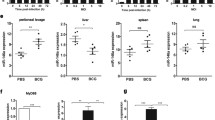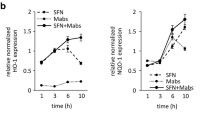Abstract
Aspergillus fumigatu (A. fumigatus) is one of the most common important fungal pathogens that cause life-threatening infectious disease in immunocompromised individuals. However, the host immune response against this pathogenic mold is not fully understood. MicroRNAs (miRNAs) play essential roles in regulating innate immunity. Thus, we investigated the function of miR-146a in inflammatory responses in macrophages after A. fumigatus stimulation in this study. We found that TNF-α and IL-6 were increased in THP-1 macrophage-like cells treated with A. fumigatus at both the mRNA and protein levels. The interaction between THP-1 macrophage-like cells and A. fumigatus resulted in a long-lasting increase in miR-146a expression dependent on p38 MAPK and NF-κB signaling. In A. fumigatus-challenged THP-1 macrophage-like cells, overexpression of miR-146a by miR-146a mimics decreased TNF-α and IL-6 production, whereas downregulation of miR-146a by anti-miR-146a significantly enhanced the level of TNF-α and IL-6. Our study demonstrates that the crosstalk between miR-146a and the inflammation-regulating p38 MAPK and NF-κB pathways might be a fine-tuning mechanism in the modulation of the inflammatory response in macrophages infected with A. fumigatus. Our findings illuminate the crucial role of miR-146a in the pathogenesis of human diseases associated with A. fumigatus infection.





Similar content being viewed by others
References
Chai LY, et al. Aspergillus fumigatus cell wall components differentially modulate host TLR2 and TLR4 responses. Microbes Infect. 2011;13(2):151–9.
Osherov N. Interaction of the pathogenic mold Aspergillus fumigatus with lung epithelial cells. Front Microbiol. 2012;3:346.
Latge JP. The pathobiology of Aspergillus fumigatus. Trends Microbiol. 2001;9(8):382–9.
Abad A, et al. What makes Aspergillus fumigatus a successful pathogen? Genes and molecules involved in invasive aspergillosis. Rev Iberoam Micol. 2010;27(4):155–82.
Steinbach WJ, et al. Clinical epidemiology of 960 patients with invasive aspergillosis from the PATH Alliance registry. J Infect. 2012;65(5):453–64.
Patterson KC, Strek ME. Diagnosis and treatment of pulmonary aspergillosis syndromes. Chest. 2014;146(5):1358–68.
Pfaller MA, Diekema DJ. Epidemiology of invasive mycoses in North America. Crit Rev Microbiol. 2010;36(1):1–53.
Segal BH. Aspergillosis. N Engl J Med. 2009;360(18):1870–84.
Brown JS, et al. Signature-tagged and directed mutagenesis identify PABA synthetase as essential for Aspergillus fumigatus pathogenicity. Mol Microbiol. 2000;36(6):1371–80.
Fontaine T, et al. Molecular organization of the alkali-insoluble fraction of aspergillus fumigatus cell wall. J Biol Chem. 2000;275(52):41528.
Bellocchio S, et al. The contribution of the Toll-like/IL-1 receptor superfamily to innate and adaptive immunity to fungal pathogens in vivo. J Immunol. 2004;172(5):3059–69.
Werner JL, et al. Requisite role for the dectin-1 beta-glucan receptor in pulmonary defense against Aspergillus fumigatus. J Immunol. 2009;182(8):4938–46.
Brown GD, Gordon S. Immune recognition A new receptor for beta-glucans. Nature. 2001;413(6851):36–7.
Drummond RA, Brown GD. The role of Dectin-1 in the host defence against fungal infections. Curr Opin Microbiol. 2011;14(4):392–9.
Plato A, Hardison SE, Brown GD. Pattern recognition receptors in antifungal immunity. Semin Immunopathol. 2015;37(2):97–106.
Saijo S, Iwakura Y. Dectin-1 and Dectin-2 in innate immunity against fungi. Int Immunol. 2011;23(8):467–72.
Gringhuis SI, et al. Selective C-Rel activation via Malt1 controls anti-fungal T(H)-17 immunity by dectin-1 and dectin-2. PLoS Pathog. 2011;7(1):e1001259.
Farh KK, et al. The widespread impact of mammalian MicroRNAs on mRNA repression and evolution. Science. 2005;310(5755):1817–21.
Taganov KD, et al. NF-kappaB-dependent induction of microRNA miR-146, an inhibitor targeted to signaling proteins of innate immune responses. Proc Natl Acad Sci USA. 2006;103(33):12481–6.
Bartel DP. MicroRNAs: genomics, biogenesis, mechanism, and function. Cell. 2004;116(2):281–97.
Zhou R, et al. NF-kappaB p65-dependent transactivation of miRNA genes following Cryptosporidium parvum infection stimulates epithelial cell immune responses. PLoS Pathog. 2009;5(12):e1000681.
O’Neill LA, Sheedy FJ, McCoy CE. MicroRNAs: the fine-tuners of Toll-like receptor signalling. Nat Rev Immunol. 2011;11(3):163–75.
Ma C, et al. microRNA-124 negatively regulates TLR signaling in alveolar macrophages in response to mycobacterial infection. Mol Immunol. 2014;62(1):150–8.
Xu G, et al. MicroRNA-149 negatively regulates TLR-triggered inflammatory response in macrophages by targeting MyD88. J Cell Biochem. 2014;115(5):919–27.
Wu Y, Sun Q, Dai L. Immune regulation of miR-30 on the Mycobacterium tuberculosis-induced TLR/MyD88 signaling pathway in THP-1 cells. Exp Ther Med. 2017;14(4):3299–303.
Monk CE, Hutvagner G, Arthur JS. Regulation of miRNA transcription in macrophages in response to Candida albicans. PLoS ONE. 2010;5(10):e13669.
Chai LY, et al. Modulation of Toll-like receptor 2 (TLR2) and TLR4 responses by Aspergillus fumigatus. Infect Immun. 2009;7:2184–92.
Han HS, et al. Identification of suitable reference genes for the relative quantification of microRNAs in pleural effusion. Oncol Lett. 2014;8(4):1889–95.
Zhang P, et al. Role of mitogen-activated protein kinases and NF-kappaB in the regulation of proinflammatory and anti-inflammatory cytokines by Porphyromonas gingivalis hemagglutinin B. Infect Immun. 2005;73(7):3990–8.
Rogers NC, et al. Syk-dependent cytokine induction by Dectin-1 reveals a novel pattern recognition pathway for C type lectins. Immunity. 2005;22(4):507–17.
Mistry P, et al. Inhibition of TLR2 signaling by small molecule inhibitors targeting a pocket within the TLR2 TIR domain. Proc Natl Acad Sci USA. 2015;112(17):5455–60.
Moser VA, Uchoa MF, Pike CJ. TLR4 inhibitor TAK-242 attenuates the adverse neural effects of diet-induced obesity. J Neuroinflammation. 2018;15(1):306.
Banerjee S, et al. miR-125a-5p regulates differential activation of macrophages and inflammation. J Biol Chem. 2013;288(49):35428–36.
Nahid MA, Satoh M, Chan EK. Mechanistic role of microRNA-146a in endotoxin-induced differential cross-regulation of TLR signaling. J Immunol. 2011;186(3):1723–34.
Saba R, Sorensen DL, Booth SA. MicroRNA-146a: A Dominant, Negative Regulator of the Innate Immune Response. Front Immunol. 2014;5:578.
Du L, et al. MiR-146a negatively regulates dectin-1-induced inflammatory responses. Oncotarget. 2017;8(23):37355–66.
Park H, et al. MicroRNA-146a and microRNA-146b regulate human dendritic cell apoptosis and cytokine production by targeting TRAF6 and IRAK1 proteins. J Biol Chem. 2015;290(5):2831–41.
Curtis AM, et al. Circadian control of innate immunity in macrophages by miR-155 targeting Bmal1. Proc Natl Acad Sci U S A. 2015;112(23):7231–6.
Hong J, Zhou W, Wang X. Involvement of miR-455 in the protective effect of H2S against chemical hypoxia-induced injury in BEAS-2B cells. Pathol Res Pract. 2018;214(11):1804–10.
Agustinho DP, et al. Dectin-1 is required for miR155 upregulation in murine macrophages in response to Candida albicans. Virulence. 2017;8(1):41–52.
Akira S, Uematsu S, Takeuchi O. Pathogen recognition and innate immunity. Cell. 2006;124(4):783–801.
Medzhitov R, Janeway C Jr. Innate immunity. N Engl J Med. 2000;343(5):338–44.
Luther K, et al. Phagocytosis of Aspergillus fumigatus conidia by murine macrophages involves recognition by the dectin-1 beta-glucan receptor and Toll-like receptor 2. Cell Microbiol. 2007;9(2):368–81.
Zhao J, Wu XY. Triggering of toll-like receptors 2 and 4 by Aspergillus fumigatus conidia in immortalized human corneal epithelial cells to induce inflammatory cytokines. Chin Med J (Engl). 2008;121(5):450–4.
Chai LY, et al. Modulation of Toll-like receptor 2 (TLR2) and TLR4 responses by Aspergillus fumigatus. Infect Immun. 2009;77(5):2184–92.
Steele C, et al. The beta-glucan receptor dectin-1 recognizes specific morphologies of Aspergillus fumigatus. PLoS Pathog. 2005;1(4):e42.
Mambula SS, et al. Toll-like receptor (TLR) signaling in response to Aspergillus fumigatus. J Biol Chem. 2002;277(42):39320–6.
Pylkkanen L, et al. Exposure to Aspergillus fumigatus spores induces chemokine expression in mouse macrophages. Toxicology. 2004;200(2–3):255–63.
Carissimi C, Fulci V, Macino G. MicroRNAs: novel regulators of immunity. Autoimmun Rev. 2009;8(6):520–4.
Xiao C, Rajewsky K. MicroRNA control in the immune system: basic principles. Cell. 2009;136(1):26–36.
Chan EK, Ceribelli A, Satoh M. MicroRNA-146a in autoimmunity and innate immune responses. Ann Rheum Dis. 2013;72(Suppl 2):ii90–5.
Sun W, et al. Selenium suppresses inflammation by inducing microRNA-146a in Staphylococcus aureus-infected mouse mastitis model. Oncotarget. 2017;8(67):110949–64.
Wen Z, et al. Autoantibody induction by DNA-containing immune complexes requires HMGB1 with the TLR2/microRNA-155 pathway. J Immunol. 2013;190(11):5411–22.
Li Z, Cai J, Cao X. MiR-19 suppresses fibroblast-like synoviocytes cytokine release by targeting toll like receptor 2 in rheumatoid arthritis. Am J Transl Res. 2016;8(12):5512–8.
Lippai D, et al. Chronic alcohol-induced microRNA-155 contributes to neuroinflammation in a TLR4-dependent manner in mice. PLoS ONE. 2013;8(8):e70945.
Kong H, et al. The Effect of miR-132, miR-146a, and miR-155 on MRP8/TLR4-Induced Astrocyte-Related Inflammation. J Mol Neurosci. 2015;57(1):28–37.
Lv YN, Ou-Yang AJ, Fu LS. MicroRNA-27a Negatively Modulates the Inflammatory Response in Lipopolysaccharide-Stimulated Microglia by Targeting TLR4 and IRAK4. Cell Mol Neurobiol. 2017;37(2):195–210.
Xue X, Qiu Y, Yang HL. Immunoregulatory role of MicroRNA-21 in macrophages in response to bacillus calmette-guerin infection involves modulation of the TLR4/MyD88 signaling pathway. Cell Physiol Biochem. 2017;42(1):91–102.
Iyer A, et al. MicroRNA-146a: a key regulator of astrocyte-mediated inflammatory response. PLoS ONE. 2012;7(9):e44789.
Lewis BP, et al. Prediction of mammalian microRNA targets. Cell. 2003;115(7):787–98.
O’Brien J, et al. Overview of MicroRNA biogenesis, mechanisms of actions, and circulation. Front Endocrinol (Lausanne). 2018;9:402.
Acknowledgements
This work was supported by grants from National Natural Science Foundation of China (No. 81773338, 81773342, 81502739), CAMS Innovation Fund for Medical Sciences (2017-I2M-1-017, 2016-I2M-1-005), “Thirteen Five” Key Medical Talent’s Project in Science and Education of Jiangsu Province (ZDRCB2016010), Jiangsu R&D program social development project (No. BE2015717), Jiang Su National Natural Science Foundation (No. BK20150068, No. BK20190144), PUMC Youth Fund (No. 3332016108).
Author information
Authors and Affiliations
Contributions
Jianbo Tong and Xu Chen wrote the main manuscript text. Jianbo Tong, Zhimin Duan, Rong Zeng, Leilei Du, Song Xu, Liwei Wang and Yuzhen Liu jointly performed the experiments, prepared all figures and performed statistical analysis in this work. Qing Chen, Xu Chen and Min Li supervised the experimental design and revised manuscript text. Qing Chen, Xu Chen and Min Li are the corresponding authors. All authors reviewed the manuscript.
Corresponding authors
Ethics declarations
Conflict of interest
The authors declare that there is no conflict of interest regarding the publication of this paper.
Additional information
Handling Editor: Anamelia Lorenzetti Bocca.
Publisher's Note
Springer Nature remains neutral with regard to jurisdictional claims in published maps and institutional affiliations.
Supplementary Information
Below is the link to the electronic supplementary material.
Rights and permissions
About this article
Cite this article
Tong, J., Duan, Z., Zeng, R. et al. MiR-146a Negatively Regulates Aspergillus fumigatus-Induced TNF-α and IL-6 Secretion in THP-1 Macrophages. Mycopathologia 186, 341–354 (2021). https://doi.org/10.1007/s11046-021-00538-0
Received:
Accepted:
Published:
Issue Date:
DOI: https://doi.org/10.1007/s11046-021-00538-0




